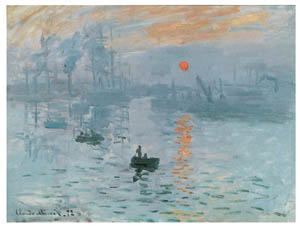Levar del sole Monet

Poster Monet Levar del Sole - cm 40x30
| Codice | Dimensioni in cm | Grammatura per mq | цена € |
Q.ty ordine |
||
|---|---|---|---|---|---|---|
| Foglio | ||||||
Levar del sole Monet -
Claude Monet (French pronunciation: [klod m?n?]), born Oscar Claude Monet (14 November 1840 – 5 December 1926), was a founder of French impressionist painting, and the most consistent and prolific practitioner of the movement's philosophy of expressing one's perceptions before nature, especially as applied to plein-air landscape painting.[1][2] The term Impressionism is derived from the title of his painting Impression, Sunrise (Impression, soleil levant).
Early life
Claude Monet was born on 14 November 1840 on the 5th floor of 45 rue Laffitte, in the 9th arrondissement of Paris.[3] He was the second son of Claude Adolphe Monet and Louise Justine Aubrée Monet, both of them second-generation Parisians. On 20 May 1841, he was baptized in the local parish church, Notre-Dame-de-Lorette, as Oscar-Claude, but his parents called him simply Oscar.[3][4] In 1845, his family moved to Le Havre in Normandy. His father wanted him to go into the family grocery business, but Monet wanted to become an artist. His mother was a singer.
On the first of April 1851, Monet entered Le Havre secondary school of the arts. Locals knew him well for his charcoal caricatures, which he would sell for ten to twenty francs. Monet also undertook his first drawing lessons from Jacques-François Ochard, a former student of Jacques-Louis David. On the beaches of Normandy in about 1856/1857, he met fellow artist Eugène Boudin, who became his mentor and taught him to use oil paints. Boudin taught Monet "en plein air" (outdoor) techniques for painting.[5] Both received the influence of Johan Barthold Jongkind.
On 28 January 1857, his mother died. At the age of sixteen, he left school and went to live with his widowed childless aunt, Marie-Jeanne Lecadre.
When Monet traveled to Paris to visit the Louvre, he witnessed painters copying from the old masters. Having brought his paints and other tools with him, he would instead go and sit by a window and paint what he saw.[citation needed] Monet was in Paris for several years and met other young painters who would become friends and fellow impressionists; among them was Édouard Manet.
In June 1861, Monet joined the First Regiment of African Light Cavalry in Algeria for a seven-year commitment, but, two years later, after he had contracted typhoid fever, his aunt intervened to get him out of the army if he agreed to complete an art course at an art school. It is possible that the Dutch painter Johan Barthold Jongkind, whom Monet knew, may have prompted his aunt on this matter. Disillusioned with the traditional art taught at art schools, in 1862 Monet became a student of Charles Gleyre in Paris, where he met Pierre-Auguste Renoir, Frédéric Bazille and Alfred Sisley. Together they shared new approaches to art, painting the effects of light en plein air with broken color and rapid brushstrokes, in what later came to be known as Impressionism.
Monet's Camille or The Woman in the Green Dress (La femme à la robe verte), painted in 1866, brought him recognition and was one of many works featuring his future wife, Camille Doncieux; she was the model for the figures in Women in the Garden of the following year, as well as for On the Bank of the Seine, Bennecourt, 1868, pictured here. Shortly thereafter, Camille became pregnant and gave birth to their first child, Jean.
Franco-Prussian War, Impressionism, and Argenteuil
After the outbreak of the Franco-Prussian War (19 July 1870), Monet took refuge in England in September 1870,[6] where he studied the works of John Constable and Joseph Mallord William Turner, both of whose landscapes would serve to inspire Monet's innovations in the study of color. In the spring of 1871, Monet's works were refused authorisation for inclusion in the Royal Academy exhibition.
In May 1871, he left London to live in Zaandam, in the Netherlands,[7] where he made twenty-five paintings (and the police suspected him of revolutionary activities).[8] He also paid a first visit to nearby Amsterdam. In October or November 1871, he returned to France. Monet lived from December 1871 to 1878 at Argenteuil, a village on the right bank of the Seine river near Paris, and a popular Sunday-outing destination for Parisians, where he painted some of his best known works. In 1874, he briefly returned to Holland.
In 1872, he painted Impression, Sunrise (Impression, soleil levant) depicting a Le Havre port landscape. It hung in the first Impressionist exhibition in 1874 and is now displayed in the Musée Marmottan Monet in Paris. From the painting's title, art critic Louis Leroy coined the term "Impressionism", which he intended as disparagement but which the Impressionists appropriated for themselves.[10] Also in this exhibition was a painting titled Boulevard des Capucines, a painting of the boulevard done from the photographer Nadar's apartment at no. 35. There were, however, two paintings by Monet of the boulevard: one is now in the Pushkin Museum in Moscow, the other in the Nelson-Atkins Museum of Art in Kansas City. It has never become clear which painting appeared in the groundbreaking 1874 exhibition, though more recently the Moscow picture has been favoured.
Monet and Camille Doncieux had married just before the war (28 June 1870)[7] and, after their excursion to London and Zaandam, they had moved to Argenteuil, in December 1871. It was during this time that Monet painted various works of modern life. Camille became ill in 1876. They had a second son, Michel, on 17 March 1878, (Jean was born in 1867). This second child weakened her already fading health. In that same year, he moved to the village of Vétheuil. On 5 September 1879, Camille Monet died of tuberculosis at the age of thirty-two; Monet painted her on her death bed.
